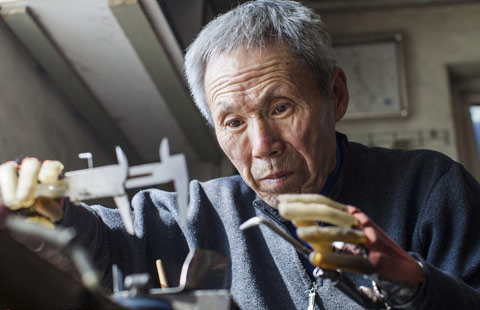Diaoyu Dao, an Inherent Territory of China
(English.news.cn) Updated: 2012-09-25 16:45III. Backroom Deals Between the United States and Japan Concerning Diaoyu Dao are Illegal and Invalid
Diaoyu Dao was returned to China after the Second World War. However, the United States arbitrarily included Diaoyu Dao under its trusteeship in the 1950s and "returned" the "power of administration" over Diaoyu Dao to Japan in the 1970s. The backroom deals between the United States and Japan concerning Diaoyu Dao are acts of grave violation of China's territorial sovereignty. They are illegal and invalid. They have not and cannot change the fact that Diaoyu Dao belongs to China.
1. Diaoyu Dao was returned to China after the Second World War
In December 1941, the Chinese government officially declared war against Japan together with the abrogation of all treaties between China and Japan. In December 1943, the Cairo Declaration stated in explicit terms that "all the territories Japan has stolen from the Chinese, such as Manchuria, Formosa [Taiwan] and the Pescadores, shall be restored to the Republic of China. Japan will also be expelled from all other territories which she has taken by violence and greed." In July 1945, the Potsdam Proclamation stated in Article 8: "The terms of the Cairo Declaration shall be carried out and Japanese sovereignty shall be limited to the islands of Honshu, Hokkaido, Kyushu, Shikoku and such minor islands as we determine." On September 2, 1945, the Japanese government accepted the Potsdam Proclamation in explicit terms with the Japanese Instrument of Surrender and pledged to faithfully fulfill the obligations enshrined in the provisions of the Potsdam Proclamation. On January 29, 1946, the Supreme Commander for the Allied Powers Instruction (SCAPIN) No.677 clearly defined Japan's power of administration to "include the four main islands of Japan (Hokkaido, Honshu, Kyushu and Shikoku) and the approximately 1,000 smaller adjacent islands, including the Tsushima Islands and the Ryukyu Islands north of the 30th parallel of North Latitude". On October 25, 1945, the ceremony for accepting Japan's surrender in Taiwan Province of the China War Theater was held in Taipei, and the Chinese government officially recovered Taiwan. On September 29, 1972, the Japanese government committed with all seriousness in the China-Japan Joint Statement that "the Government of Japan fully understands and respects this stand of the Government of the People's Republic of China [Taiwan is an inalienable part of the territory of the People's Republic of China], and it firmly maintains its stand under Article 8 of the Potsdam Proclamation."
These facts show that in accordance with the Cairo Declaration, the Potsdam Proclamation and the Japanese Instrument of Surrender, Diaoyu Dao, as affiliated islands of Taiwan, should be returned, together with Taiwan, to China.
2. The United States illegally included Diaoyu Dao under its trusteeship
On September 8, 1951, Japan, the United States and a number of other countries signed the Treaty of Peace with Japan (commonly known as the Treaty of San Francisco) with China being excluded from it. The treaty placed the Nansei Islands south of the 29th parallel of North Latitude under United Nations' trusteeship, with the United States as the sole administering authority. It should be pointed out that the Nansei Islands placed under the administration of the United States in the Treaty of Peace with Japan did not include Diaoyu Dao.
The United States Civil Administration of the Ryukyu Islands (USCAR) issued Civil Administration Ordinance No. 68 (Provisions of the Government of the Ryukyu Islands) on February 29, 1952 and Civil Administration Proclamation No. 27 (defining the "geographical boundary lines of the Ryukyu Islands") on December 25, 1953, arbitrarily expanding its jurisdiction to include China's Diaoyu Dao. However, there were no legal grounds whatsoever for the US act, to which China has firmly opposed.
3. The United States and Japan conducted backroom deals concerning the "power of administration" over Diaoyu Dao
On June 17, 1971, Japan and the United States signed the Agreement Concerning the Ryukyu Islands and the Daito Islands (Okinawa Reversion Agreement), which provided that any and all powers of administration over the Ryukyu Islands and Diaoyu Dao would be "returned" to Japan. The Chinese people, including overseas Chinese, all condemned such a backroom deal. On December 30, 1971, the Chinese Ministry of Foreign Affairs issued a solemn statement, pointing out that "it is completely illegal for the government of the United States and Japan to include China's Diaoyu Dao Islands into the territories to be returned to Japan in the Okinawa Reversion Agreement and that it can by no means change the People's Republic of China's territorial sovereignty over the Diaoyu Dao Islands". The Taiwan authorities also expressed firm opposition to the backroom deal between the United States and Japan.
In response to the strong opposition of the Chinese government and people, the United States had to publicly clarify its position on the sovereignty over Diaoyu Dao. In October 1971, the US administration stated that "the United States believes that a return of administrative rights over those islands to Japan, from which the rights were received, can in no way prejudice any underlying claims. The United States cannot add to the legal rights Japan possessed before it transferred administration of the islands to us, nor can the United States, by giving back what it received, diminish the rights of other claimants... The United States has made no claim to Diaoyu Dao and considers that any conflicting claims to the islands are a matter for resolution by the parties concerned." In November 1971, when presenting the Okinawa Reversion Agreement to the US Senate for ratification, the US Department of State stressed that the United States took a neutral position with regard to the competing Japanese and Chinese claims to the islands, despite the return of administrative rights over the islands to Japan.
- Beijing exhibits proving Diaoyu sovereignty
- Taiwan fishing boats leave Diaoyu Islands after protest
- Japan opposes China's Diaoyu map bid at UN
- Taiwan boats arrive in Diaoyu Islands waters
- Artifacts offer ancient proof on Diaoyu Islands
- Japan's 'theft' of Diaoyu Islands risks ties
- Japan blamed for consequence of Diaoyu 'buying'
- 75 Taiwan fishing boats sail to Diaoyu Islands
- 2 Chinese vessels enter waters near Diaoyu Islands
- Taiwan states protest against Japan over Diaoyu Islands
- China to help alleviate drought along Mekong River
- Churches face severe shortage of clergy in the country
- Soybean province wants protection from GM crops
- Subsidy promotes care of mentally ill
- Anti-graft campaign targets poverty relief
- 'Zombie companies' adjust to new reality
- Car-hailing companies' subsidies unfair competition, minister say
- China-US team uses stem cells in cataract treatment
- Farmer films wild giant panda with cellphone
- For nation's anti-graft campaign, no slowdown







